2003 GMC SIERRA DENALI weight
[x] Cancel search: weightPage 263 of 428
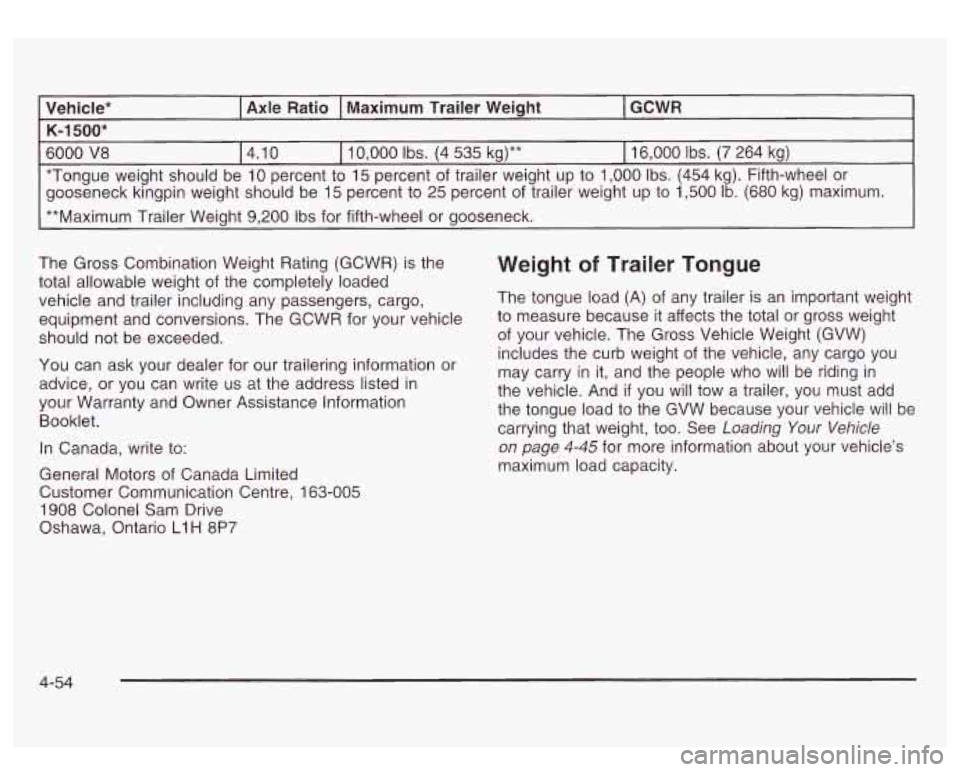
**Maximum Trailer Weight 9,200 Ibs for fifth-wheel or gooseneck.
The Gross Combination Weight Rating (GCWR) is the
total allowable weight of the completely loaded
vehicle and trailer including any passengers, cargo,
equipment and conversions. The GCWR for your vehicle
should not be exceeded.
You can ask your dealer for our trailering information or
advice, or you can write us at the address listed in
your Warranty and Owner Assistance Information
Booklet.
In Canada, write to:
General Motors of Canada Limited
Customer Communication Centre,
163-005
1908 Colonel Sam Drive
Oshawa. Ontario L1
H 8P7
Weight of Trailer Tongue
The tongue load (A) of any trailer is an important weight
to measure because it affects the total or gross weight
of your vehicle. The Gross Vehicle Weight (GVW)
includes the curb weight of the vehicle, any cargo you
may carry in it, and the people who will be riding in
the vehicle. And
if you will tow a trailer, you must add
the tongue load to the GVW because your vehicle will be
carrying that weight, too. See
Loading Your Vehicle
on page
4-45 for more information about your vehicle’s
maximum load capacity.
4-54
Page 264 of 428
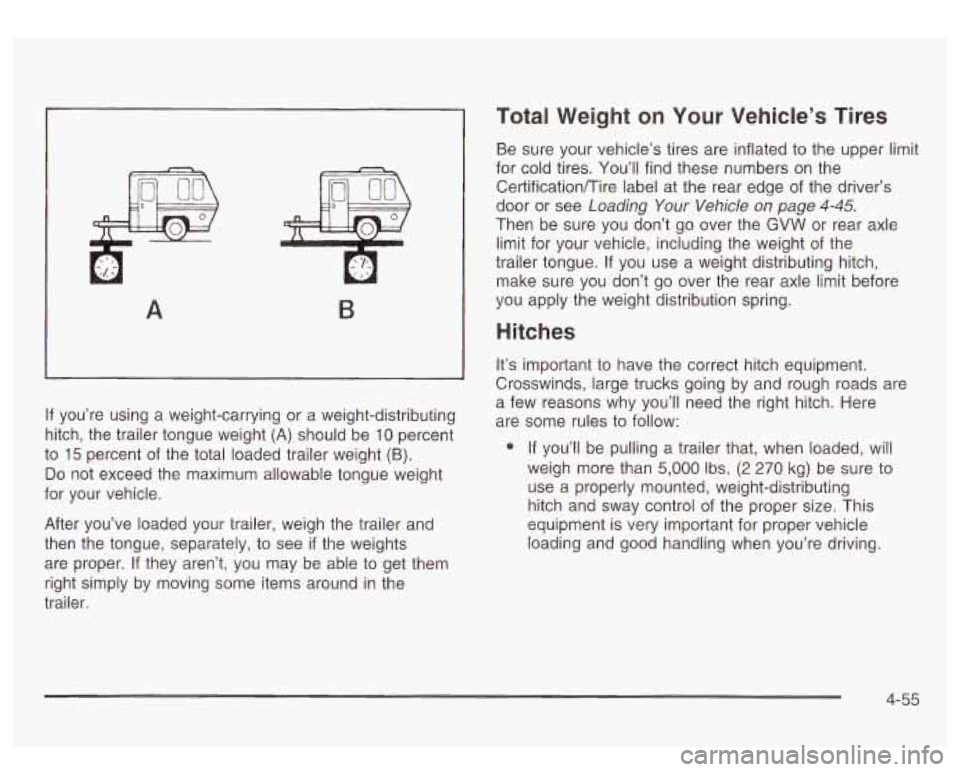
A B
If you’re using a weight-carrying or a weight-distributing
hitch, the trailer tongue weight
(A) should be 10 percent
to
15 percent of the total loaded trailer weight (B).
Do not exceed the maximum allowable tongue weight
for your vehicle.
After you’ve loaded your trailer, weigh the trailer and
then the tongue, separately, to see
if the weights
are proper. If they aren’t, you may be able to get them
right simply by moving some items around in the
trailer.
Total Weight on Your Vehicle’s Tires
Be sure your vehicle’s tires are inflated to the upper limit
for cold tires. You’ll find these numbers on the
Certificationnire label at the rear edge of the driver’s
door or see
Loading Your Vehicle on page 4-45.
Then be sure you don’t go over the GVW or rear axle
limit for your vehicle, including the weight of the
trailer tongue.
If you use a weight distributing hitch,
make sure you don’t go over the rear axle limit before
you apply the weight distribution spring.
Hitches
It’s important to have the correct hitch equipment.
Crosswinds, large trucks going by and rough roads are
a few reasons why you’ll need the right hitch, Here
are some rules to follow:
0 If you’ll be pulling a trailer that, when loaded, will
weigh more than
5,000 lbs. (2 270 kg) be sure to
use a properly mounted, weight-distributing
hitch and sway control of the proper size. This
equipment is very important for proper vehicle
loading and good handling when you’re driving.
4-55
Page 265 of 428
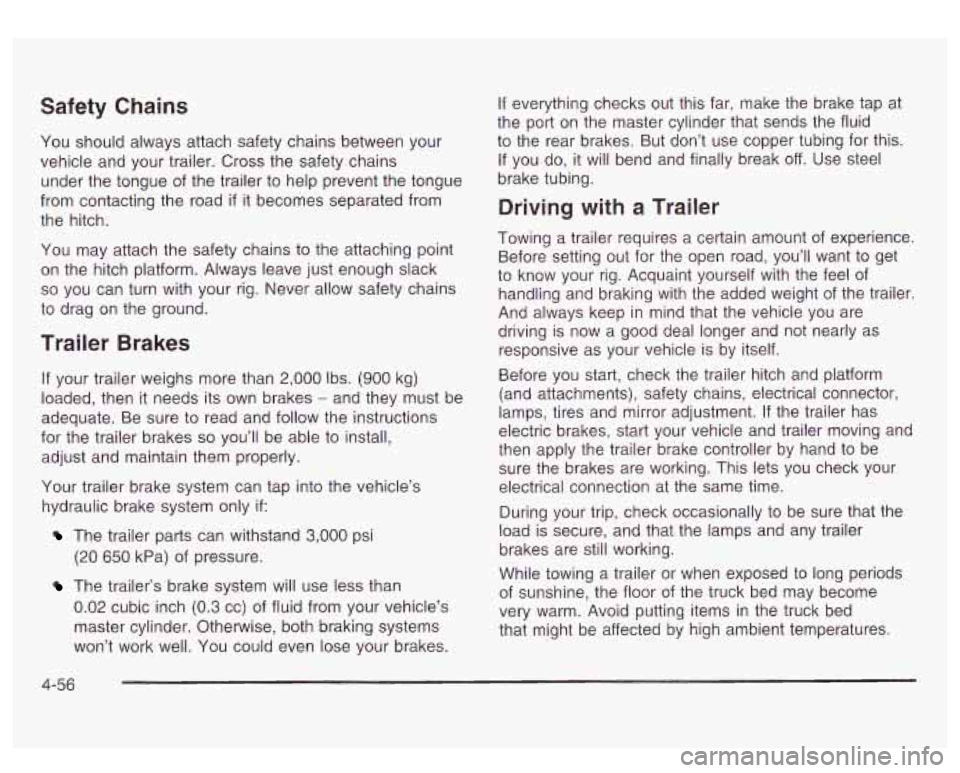
Safety Chains
You should always attach safety chains between your
vehicle and your trailer. Cross the safety chains
under the tongue of the trailer to help prevent the tongue
from contacting the road
if it becomes separated from
the hitch.
You may attach the safety chains to the attaching point
on the hitch platform. Always leave just enough slack
so you can turn with your rig. Never allow safety chains
to drag on the ground.
Trailer Brakes
If your trailer weighs more than 2,000 Ibs. (900 kg)
loaded, then it needs its own brakes
- and they must be
adequate. Be sure to read and follow the instructions
for the trailer brakes
so you’ll be able to install,
adjust and maintain them properly.
Your trailer brake system can tap into the vehicle’s
hydraulic brake system only
if:
(20 650 kPa) of pressure.
The trailer parts can withstand 3,000 psi
The trailer’s brake system will use less than
0.02 cubic inch (0.3 cc) of fluid from your vehicle’s
master cylinder. Otherwise, both braking systems
won’t work well. You could even lose your brakes. If
everything checks out this far, make the brake tap at
the
port on the master cylinder that sends the fluid
to the rear brakes. But don’t use copper tubing for this.
If you do, it will bend and finally break off. Use steel
brake tubing.
Driving with a Trailer
Towing a trailer requires a certain amount of experience.
Before setting out for the open road, you’ll want to get
to know your rig. Acquaint yourself with the feel of
handling and braking with the added weight of the trailer.
And always keep in mind that the vehicle you are
driving is now a good deal longer and not nearly as
responsive as your vehicle is by itself.
Before you start, check the trailer hitch and platform
(and attachments), safety chains, electrical connector,
lamps, tires and mirror adjustment. If the trailer has
electric brakes, start your vehicle and trailer moving and
then apply the trailer brake controller by hand to be
sure the brakes are working. This lets you check your
electrical connection at the same time.
During your trip, check occasionally to be sure that the
load is secure, and that the lamps and any trailer
brakes are still working.
While towing a trailer or when exposed to long periods
of sunshine, the floor of the truck bed may become
very warm. Avoid putting items in the truck bed
that might be affected by high ambient temperatures.
4-56
Page 409 of 428
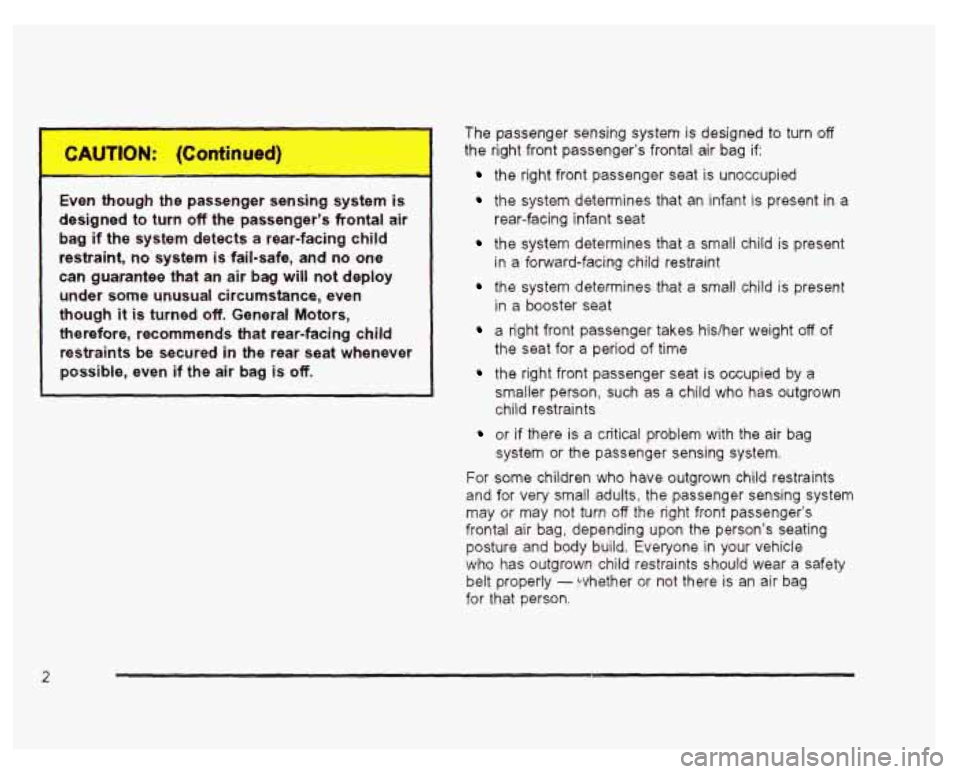
Even though the passenger sensing system is
designed to turn
off the passenger’s frontal air
bag if
the system detects a rear-facing child
restraint, no system
is fail-safe, and no one
can guarantee that an air bag will not deploy
under some unusual circumstance, even
though it
is turned off. General Motors,
therefore, recommends that rear-facing child
restraints be secured
in the rear seat whenever
~ possible, even if the air bag is off.
The passenger sensing system is designed to turn off
the right front passenger’s frontal air bag if:
the right front passenger seat is unoccupied
the system determines that an infant is present in a
the system determines that a small child is present
rear-facing infant seat
in a forward-facing child restraint
the system determines that a small child is present
in
a booster seat
a right front passenger takes hislher weight off of
the seat for a period of time
the right front passenger seat is occupied by a
smaller person, such as a child
who has outgrown
child restraints
or if there is a critical problem with the air bag
system or the passenger sensing system.
For
some children who have outgrown child restraints
and for
very small adults, the passenger sensing system
may
or may not turn off the right front passenger’s
frontal air bag, depending upon the person’s seating
posture and body build. Everyone in your vehicle
who has outgrown child restraints should wear
a safety
belt properly
- whether or not there is an air bag
for that person.
2
Page 423 of 428
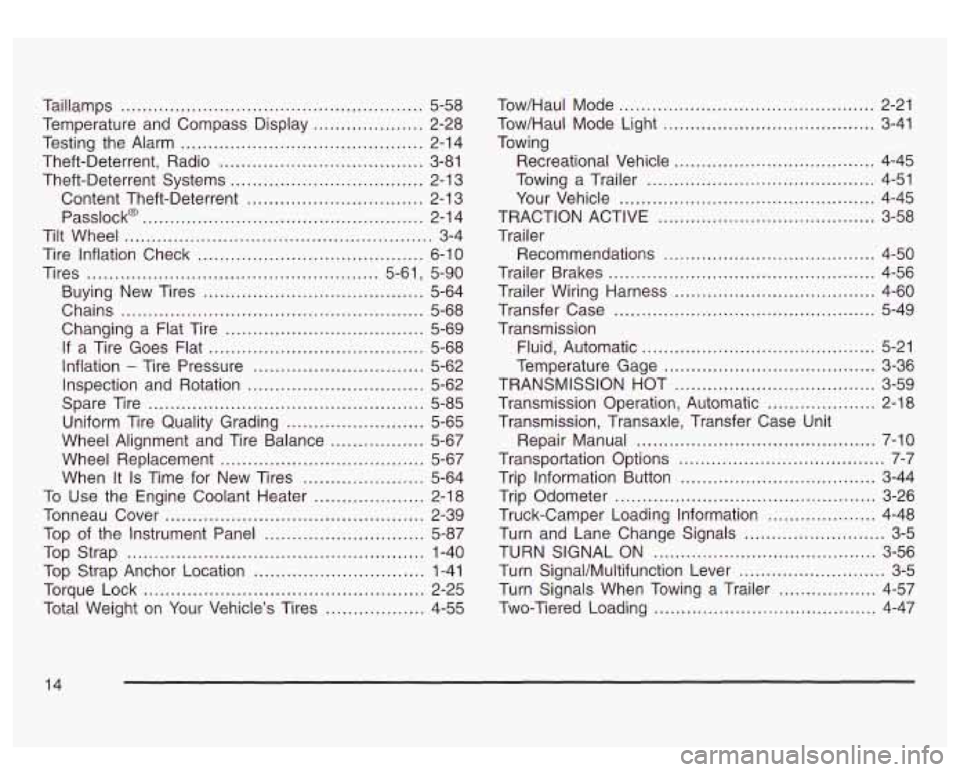
Taillamps ....................................................... 5-58
Temperature and Compass Display
.................... 2-28
Testing the Alarm
............................................ 2-14
Theft.Deterrent. Radio
..................................... 3-81
Theft-Deterrent Systems
................................... 2-1 3
Content Theft-Deterrent
................................ 2-1 3
Passlock@
................................................... 2-1 4
Tilt Wheel
........................................................ 3-4
Tire Inflation Check
......................................... 6-10
Tires
..................................................... 5.61. 5-90
Buying New Tires
........................................ 5-64
Chains
....................................................... 5-68
Changing a Flat Tire
.................................... 5-69
If a Tire Goes Flat ....................................... 5-68
Inflation
- Tire Pressure ............................... 5-62
Inspection and Rotation
................................ 5-62
Spare Tire
.................................................. 5-85
Uniform Tire Quality Grading
......................... 5-65
Wheel Alignment and Tire Balance
................. 5-67
Wheel Replacement
..................................... 5-67
When It
Is Time for New Tires ...................... 5-64
To Use the Engine Coolant Heater .................... 2-18
Tonneau Cover
............................................ 2-39
Top of the Instrument Panel
.......... ........ 5-87
Top Strap
...................................................... 1-40
Top Strap Anchor Location
............................... 1-41
Torque Lock
................................................... 2-25
Total Weight on Your Vehicle’s Tires
.................. 4-55 Tow/Haul
Mode
............................................... 2-21
Tow/Haul Mode Light
....................................... 3-41
Towing Recreational Vehicle
..................................... 4-45
Towing a Trailer
.......................................... 4-51
Your Vehicle
............................................... 4-45
TRACTION ACTIVE
.................................... 3-58
Trailer Recommendations
....................................... 4-50
Trailer Brakes
................................................. 4-56
Trailer Wiring Harness
..................................... 4-60
Transfer Case
................................................ 5-49
Transmission Fluid, Automatic
.......................... ......... 5-21
Temperature Gage
....................................... 3-36
TRANSMISSION HOT
..................................... 3-59
Transmission Operation, Automatic
.................... 2-18
Transmission, Transaxle, Transfer Case Unit Repair Manual
............................................ 7-10
Transportation Options
...................................... 7-7
Trip Information Button
....................... ..... 3-44
Trip Odometer
................................................ 3-26
Truck-Camper Loading Information
.................... 4-48
Turn and Lane Change Signals
.......................... 3-5
Turn SignaVMultifunction Lever ........................... 3-5
Turn Signals When Towing a Trailer
.................. 4-57
Two-Tiered Loading
......................................... 4-47
TURN
SIGNAL ON
......................................... 3-56
14
Page 424 of 428
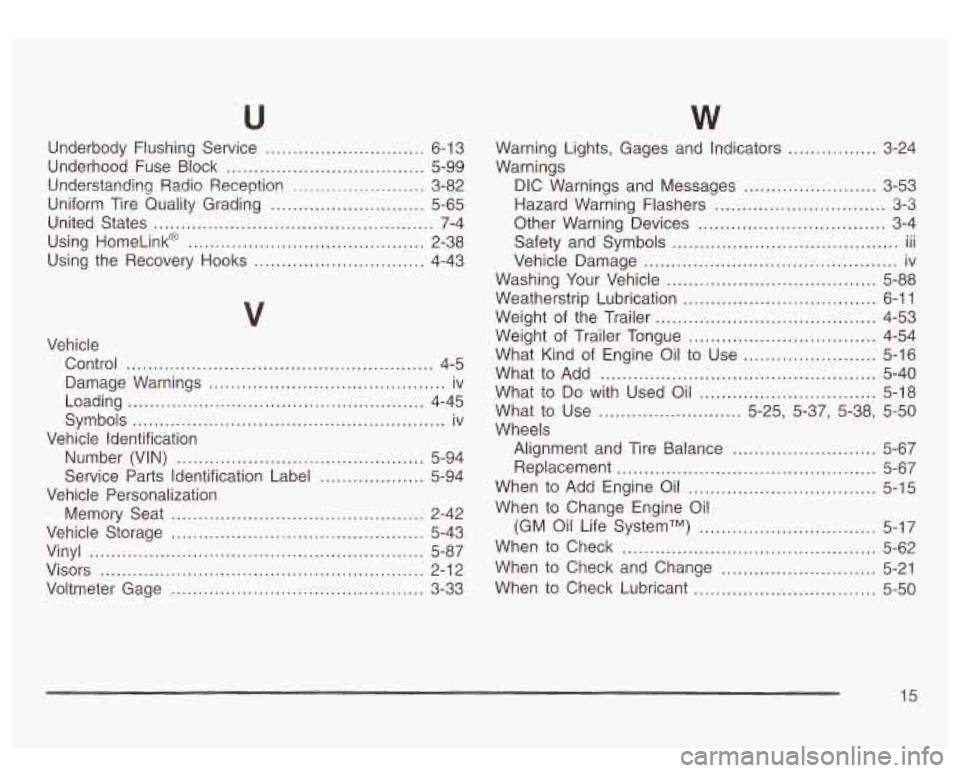
W
Underbody Flushing Service ............................. 6-1 3
Underhood Fuse Block
.................................... 5-99
Understanding Radio Reception
........................ 3-82
Using HomeLink@
........................................... 2-38
Using the Recovery Hooks
............................ 4-43
Uniform Tire
Quality Grading
............................ 5-65
United States
................................................... 7-4
v
Vehicle
Control
....................................... ......... 4-5
Damage Warnings
........................................ iv
Loading
....................................... ........ 4-45
Symbols
......................................................... iv
Vehicle Identification
Number (VIN)
............................................. 5-94
Service Parts Identification Label
................... 5-94
Vehicle Personalization Memory Seat
.......................................... 2-42
Vehicle Storage
.............................................. 5-43
Vinyl
............................................................. 5-87
Visors
........................................................... 2-1 2
Voltmeter Gage
.......................................... 3-33 Warning Lights. Gages and
Indicators
................ 3-24
Warnings DIC Warnings and Messages
........................ 3-53
Other Warning Devices
.................................. 3-4 ...
Safety and Symbols ......................................... III
Washing Your Vehicle ...................................... 5-88
Hazard Warning
Flashers
............................... 3-3
Vehicle Damage .............................................. iv
Weatherstrip Lubrication
................................... 6-11
Weight of the Trailer
........................................ 4-53
Weight of Trailer Tongue
.................................. 4-54
What to Add
.................................................. 5-40
What to
Do with Used Oil ................................ 5-18
What
Kind
of Engine Oil to Use ........................ 5-16
What to Use
.......................... 5-25, 5-37, 5-38, 5-50
Wheels Alignment and Tire Balance
.......................... 5-67
Replacement
............................................... 5-67
When to Add Engine Oil
.................................. 5-15
(GM Oil Life SystemTM)
................................ 5-17
When
to Change Engine Oil
When to Check
.............................................. 5-62
When to Check and Change
............................ 5-21
When to Check Lubricant
................................. 5-50
15